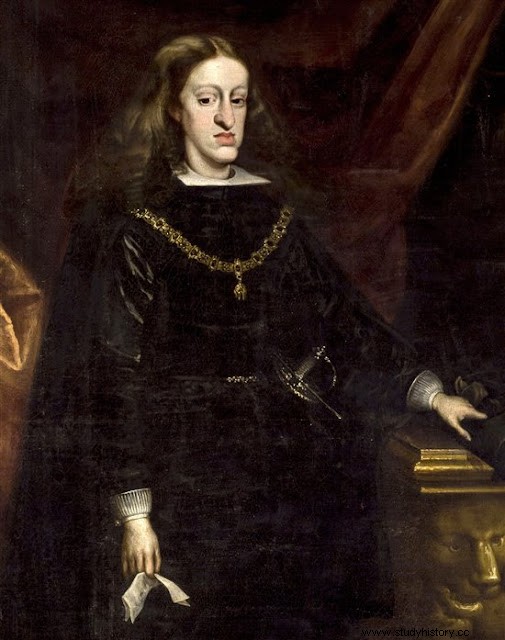
Carlos II "The Bewitched" suffered from Klinefelter syndrome
The typical "Habsburg jaw" that members of this lineage present was reinforced by the dominant inbreeding in the family for almost 200 years.Everyone knows that the last Habsburg king of Spain, Carlos II, nicknamed "The Bewitched", died without descendants after an unhappy life marked by illness and congenital malformations. The many portraits of him could not disguise the appearance of a man who, as a French ambassador described, was "sickly looking, narrow forehead, uncertain gaze, drooping lip, disproportionate body and clumsy gestures." Carlos II contained in himself the compendium of all the facial deformations of the Habsburgs:a large nose with a protruding tip that falls on the lower lip, also prominent, and a lower jaw with a pronounced prognathism.
A study that analyzes facial malformations suffered by members of the Habsburg dynasty, including many Spanish monarchs, their wives and their children. The research team has been made up of geneticists from the University of Santiago de Compostela, including Román Vilas and Gonzalo Álvarez, and also by ten maxillofacial surgeons, led by Florencio Monje, president of the Spanish Society of Oral and Maxillofacial Surgery and of Head and Neck. It suggests that the typical "Habsburg jaw" that members of this lineage present, whose main characteristic is their pronounced prognathism, was reinforced by the dominant inbreeding in the family for more than 200 years. Thus, a close relationship has been detected between consanguinity (whose extension has been calculated from a family tree with more than 6,000 individuals belonging to more than 20 generations) and the degree of mandibular prognathism, and also with maxillary deficiency, although this, apparently, to a lesser degree. For example, if Felipe el Hermoso had a degree of consanguinity of 0.025, that of Carlos II, the last representative of the dynasty in Spain, was 0.25, which means that 25% of his genes were repeated.
REVELATING PORTRAITS
To carry out this research, a total of 66 portraits of fifteen members of the Habsburg dynasty preserved in some of the world's great museums, such as the Prado Museum or the Vienna Art History Museum (of these two institutions come from 70% of the analyzed tables). The specialists were able to classify from the portraits eleven characteristics of maxillary deficiency and seven of mandibular prognathism. The study begins with María de Borgoña, wife of Emperor Maximilian I of Habsburg, who is the one who shows fewer signs of maxillary deficiency and mandibular prognathism. Then it has continued with their son, Felipe el Hermoso, his father, Emperor Maximilano I himself, and Felipe's wife, Juana de Castilla, and the investigation ends with Carlos II, the last and unfortunate exponent of the dynasty in Spain.
 CHARLES I OF SPAIN AND V GERMANY (1500-1558) WAS THE SON OF JUANA I OF CASTILLA AND PHILIP THE BEAUTIFUL.
CHARLES I OF SPAIN AND V GERMANY (1500-1558) WAS THE SON OF JUANA I OF CASTILLA AND PHILIP THE BEAUTIFUL. Portraits of Margarita de Austria, sister of Felipe el Hermoso, were also analyzed, which turned out to be the one with the highest degree of maxillary deficiency, and it has been followed with Carlos I and Isabel of Portugal, Felipe II and their wives. Elizabeth of Valois and Anne of Austria, Philip III and Margaret of Austria, and Philip IV (the monarch with the highest degree of prognathism, according to the study) and their two wives, Mariana of Austria (who was his niece) and Elizabeth of Bourbon. The first two wives of Philip II, Maria of Portugal and Maria I of England, have not been analyzed as researchers were unable to find sufficiently reliable portraits of them to draw conclusions.
The Habsburgs formed several generations of endogamous marriages whose main objective was to ensure the influence of the family in Europe from the 16th to the 18th centuries, but what they could not know in any way is that precisely what they thought would make them more powerful was what would end their dynasty in the long run. . The study authors conclude that "the causes of the relationship between inbreeding and facial deformity remain unclear, the main effect of mating between relatives being an increased chance that offspring will inherit identical forms of a gene from both This reduces the genetic fitness of individuals, so 'Habsburg jaw' should be considered a recessive condition."
